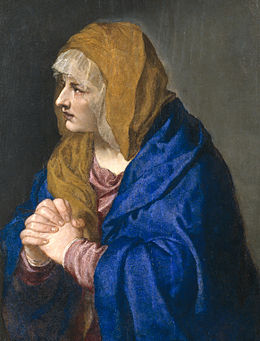
Tiziano Vecelli or Vecellio, known in English as Titian, was an Italian (Venetian) painter of the Renaissance, considered the most important member of the 16th-century Venetian school. He was born in Pieve di Cadore, near Belluno. During his lifetime he was often called da Cadore, 'from Cadore', taken from his native region.

The Prado Museum, officially known as Museo Nacional del Prado, is the main Spanish national art museum, located in central Madrid. It is widely considered to house one of the world's finest collections of European art, dating from the 12th century to the early 20th century, based on the former Spanish royal collection, and the single best collection of Spanish art. Founded as a museum of paintings and sculpture in 1819, it also contains important collections of other types of works. The Prado Museum is one of the most visited sites in the world and is considered one of the greatest art museums in the world. The numerous works by Francisco Goya, the single most extensively represented artist, as well as by Hieronymus Bosch, El Greco, Peter Paul Rubens, Titian, and Diego Velázquez, are some of the highlights of the collection. Velázquez and his keen eye and sensibility were also responsible for bringing much of the museum's fine collection of Italian masters to Spain, now one of the largest outside Italy.

Our Lady of Sorrows, Our Lady of Dolours, the Sorrowful Mother or Mother of Sorrows, and Our Lady of Piety, Our Lady of the Seven Sorrows or Our Lady of the Seven Dolours are names by which Mary, mother of Jesus, is referred to in relation to sorrows in life. As Mater Dolorosa, it is also a key subject for Marian art in the Catholic Church.

The Venetian painter Titian and his workshop made at least six versions of the same composition showing Danaë, painted between about 1544 and the 1560s. The scene is based on the mythological princess Danaë, as – very briefly – recounted by the Roman poet Ovid, and at greater length by Boccaccio. She was isolated in a bronze tower following a prophecy that her firstborn would eventually kill her father. Although aware of the consequences, Danaë was seduced and became pregnant by Zeus, who, inflamed by lust, descended from Mount Olympus to seduce her in the form of a shower of gold.
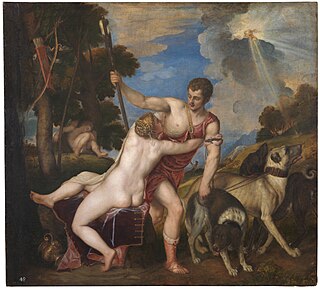
A composition of Venus and Adonis by the Venetian Renaissance artist Titian has been painted a number of times, by Titian himself, by his studio assistants and by others. In all there are some thirty versions that may date from the 16th century, the nudity of Venus undoubtedly accounting for this popularity. It is unclear which of the surviving versions, if any, is the original or prime version, and a matter of debate how much involvement Titian himself had with surviving versions. There is a precise date for only one version, that in the Prado in Madrid, which is documented in correspondence between Titian and Philip II of Spain in 1554. However, this appears to be a later repetition of a composition first painted a considerable time earlier, possibly as early as the 1520s.

The Worship of Venus is an oil on canvas painting by the Italian artist Titian completed between 1518 and 1519, housed at the Museo del Prado in Madrid, Spain. It describes a Roman rite of worship conducted in honour of the goddess Venus each 1 April. On this occasion, women would make offerings to representations of the goddess so as to cleanse "every blemish on their bodies".
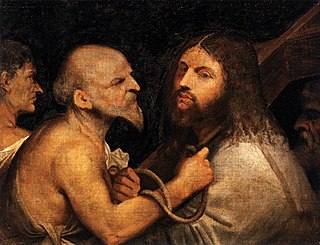
Christ Carrying the Cross is an oil painting attributed to either Titian or Giorgione. It is dated to about 1505. The painting is housed in the Scuola Grande di San Rocco in Venice, Italy. There are several later versions of the subject by Titian.
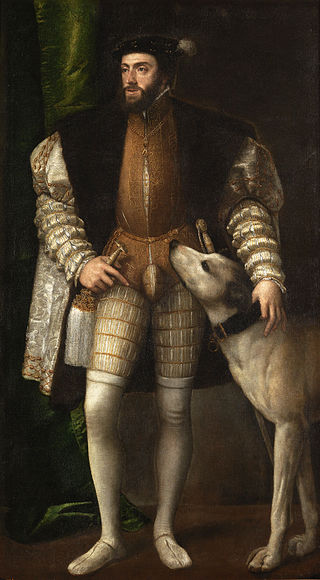
The Portrait of Karl V with a Dog is a portrait of Karl V, Holy Roman Emperor with a hunting dog, painted by Titian in 1533. It passed from Karl to the Spanish royal collection, from which it passed to its present owner, the Prado in Madrid.
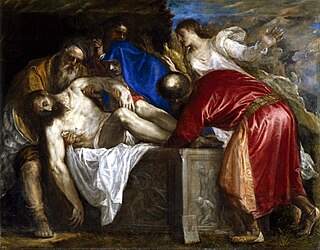
The Entombment is a 1559 oil-on-canvas painting by the Venetian painter Titian, commissioned by Philip II of Spain. It depicts the burial of Jesus in a stone sarcophagus, which is decorated with depictions of Cain and Abel and the binding of Isaac. The painting measures 137 cm × 175 cm and is now in the Museo del Prado in Madrid. Titian made several other paintings depicting the same subject, including a similar version of 1572 given as a gift to Antonio Pérez and now also in the Prado, and an earlier version of c.1520 made for the Duke of Mantua and now in the Louvre.

The Bacchanal of the Andrians or The Andrians is an oil painting by Titian. It is signed "TICIANUS F.[aciebat]" and is dated to 1523–1526.
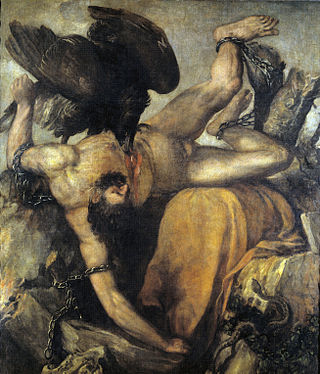
Tityus is a mythological painting by Titian dating to 1549 in the Museo del Prado, Madrid. It shows the punishment of the giant Tityos from Greek mythology.

Venus and Musician refers to a series of paintings by the Venetian Renaissance painter Titian.

Alfonso d'Avalos Addressing his Troops is a portrait of Alfonso d'Avalos by Titian, painted in around 1540 and now held at the Museo del Prado in Madrid, Spain. Alfonso d'Avalos, Marquise del Vasto, was a noble Neapolitan, descended from a family of Castilian origin. He participated in the Battle of Pavia and the conquest of Tunis in 1535. In 1538 he was appointed governor of Milan. Military failures caused a subsequent falling out of favor with the Emperor Charles V.

The Fall of Man is a painting of the Fall of Man or story of Adam and Eve by the Venetian artist Titian, dating to around 1550 and now in the Prado in Madrid. It is influenced by Raphael's fresco of the same subject in the Stanza della Signatura in the Vatican, which also had a seated Adam and standing Eve, as well as Albrecht Dürer's engraving Adam and Eve for smaller details. Owned at one point by Philip II of Spain's secretary, Antonio Pérez, and perhaps first commissioned by his father, in 1585 it entered the Spanish royal collection, where it was copied by Rubens between 1628 and 1629 for his own version of the subject.

La Gloria is a painting by Titian, commissioned by Charles V in 1550 or 1551 and completed in 1554. It was first given this title by José Sigüenza in 1601 — it is also known as The Trinity, The Final Judgement, Paradise, and Adoration of the Trinity.

The Pardo Venus is a painting by the Venetian artist Titian, completed in 1551 and now in the Louvre Museum. It is also known as Jupiter and Antiope, since it seems to show the story of Jupiter and Antiope from Book VI of the Metamorphoses. It is Titian's largest mythological painting, and was the first major mythological painting produced by the artist for Philip II of Spain. It was long kept in the Royal Palace of El Pardo near Madrid, hence its usual name; whether Venus is actually represented is uncertain. It later belonged to the English and French royal collections.

Ixion is a 1632 oil painting, signed and dated by Jusepe de Ribera. It shows a scene from Classical mythology, of Ixion being tortured as the eternal punishment meted out by Zeus. It is one of a series of four paintings by Ribera of the four "Furies" or "Condemned" from Greek mythology. It is held by the Museo del Prado in Madrid, along with Ribera's painting of Tityos; the other two, of Sisyphus and Tantalus, are lost.
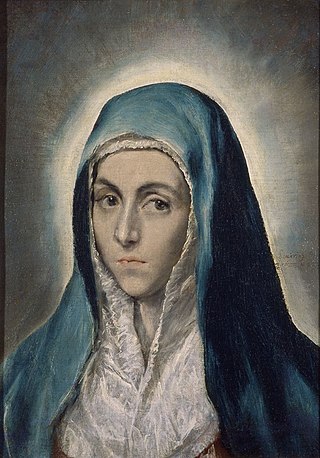
The Virgin Mary, also known as Mater Dolorosa, although this title is now considered misleading, is a late 1590s or early 1600s painting by the Greek born, Spanish Mannerist painter Doménikos Theotokópoulos. It is on display in the Musée des Beaux-Arts of Strasbourg, France. Its inventory number is 276. A similar looking canvas in the Museo del Prado is considered a weaker replica.

Salome, also known as Salome with the Head of John the Baptist, is an oil painting by the Venetian painter Titian, made in about 1550, and currently in the collection of the Museo del Prado in Madrid. It is not to be confused with other compositions of Salome and Judith by Titian.
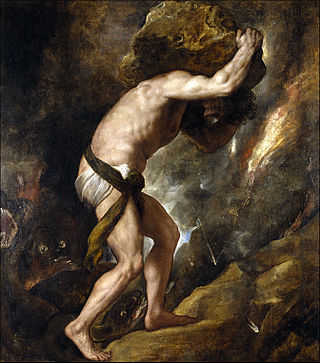
Sisyphus is an oil painting by the Venetian master Titian, made in 1548 or 1549. It is in the collection of the Museo del Prado in Madrid.
